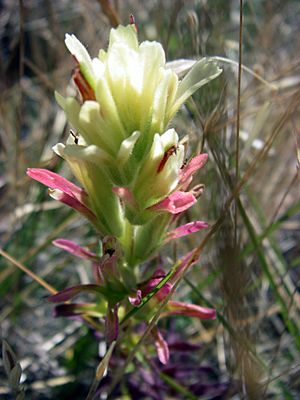Castilleja neglecta facts for kids
Quick facts for kids Castilleja neglecta |
|
|---|---|
 |
|
| Conservation status | |
| Scientific classification | |
| Genus: |
Castilleja
|
| Species: |
neglecta
|
| Synonyms | |
|
Castilleja affinis subsp. neglecta (Zeile) Chuang & Heckard |
|
The Tiburon paintbrush (scientific name: Castilleja neglecta) is a special flowering plant. It is an endangered plant, which means it is at risk of disappearing forever. You can only find this plant in a small area of California, specifically around the San Francisco Bay Area. It grows in Marin, Napa, and Santa Clara Counties. Both the state of California and the United States government have listed it as a plant that needs protection.
Contents
What Does the Tiburon Paintbrush Look Like?
This plant is a type of perennial herb. This means it's a plant that lives for more than two years, and it doesn't have a woody stem like a tree. Its stem can be anywhere from 15 to 60 centimeters (about 6 to 24 inches) tall. It often looks a bit bristly and can be green or purplish.
Its leaves are shaped like a spear, about 2 to 4 centimeters long. They might be smooth or have small lobes, which are rounded parts.
Flowers and Colors
The flowers of the Tiburon paintbrush grow in a cluster called an inflorescence. This cluster can be up to 2.5 centimeters wide. Around the flowers, there are colorful leaf-like parts called bracts. These bracts can be yellow, pink, or even reddish-orange.
The actual flowers are about 2 centimeters long. They can be green or purple, often with red or yellow edges.
Where Does It Grow?
This plant has a very specific home. It grows in a special type of soil called serpentine soil. This soil is found in certain areas and is rich in minerals that many other plants cannot tolerate. The Tiburon paintbrush grows in these areas at elevations below 300 meters (about 984 feet).
Why Is It Endangered?
The Tiburon paintbrush is endangered because it only grows in a very small area. This makes it vulnerable to changes in its habitat. When its natural home is disturbed or destroyed, the plant has fewer places to grow. Protecting its specific serpentine soil habitat is very important for its survival.
See also
 In Spanish: Castilleja affinis para niños
In Spanish: Castilleja affinis para niños


